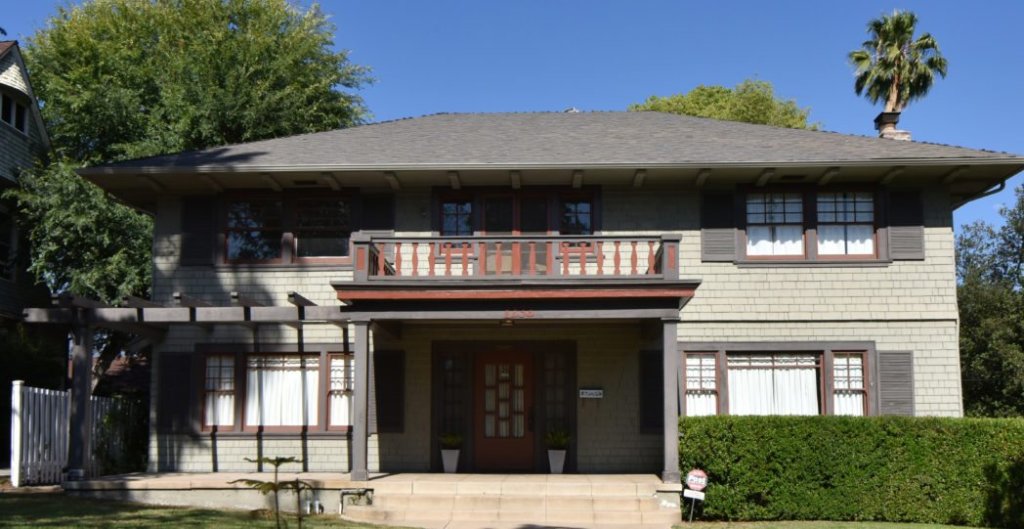 View Winners →
View Winners → Craftsman Heights Neighborhood Closes in on Landmark Status

By Gus Herrera
The Craftsman Heights neighborhood of Pasadena recently completed phase two of its journey towards achieving landmark district designation.
At their latest meeting, the city’s historic preservation commission unanimously agreed that Craftsman Heights indeed deserves landmark status, which comes with several benefits and responsibilities for its residents.
The picturesque northwestern Pasadena neighborhood has been dubbed the “donut hole,” as it is surrounded by four districts that have already achieved landmark or historic designation: Orange Heights Barnhart District to the south (also listed in the National Historic Register), Garfield Heights Landmark District to the west, Washington Square Landmark District to the east, and Normandie Heights Landmark District to the north.
Much to the delight of the numerous property owners in attendance, who cheered and applauded the HP commission’s decision, their neighborhood might soon be able to shed its pastry-themed nickname.
The journey began approximately seven years ago, when residents formed the Craftsman Heights Neighborhood Association with the primary goals of creating the landmark district and promoting neighborhood cohesiveness, according to CHNA board member and secretary Kim Perkins.
Their march picked up steam two years ago, when the demolishing of two historic homes in the neighborhood re-invigorated efforts for landmark designation.
The CHNA began circulating a petition and informational brochures which created enough momentum to host a neighborhood meeting in July 2016.
Out of the 192 property owners, Craftsman Heights’ application was able to receive 105 signatures, securing a simple majority of approximately 55 percent.
With the HP commission’s approval, the district must now complete the second half of the designation process by going before the planning commission and city council for public hearings.
Craftsman Heights hopes to become the city’s 26th landmark district – 24 Pasadena districts currently hold the designation and the potential 25th (Roosevelt Oakdale) is scheduled for city council action later this month. Twenty of Pasadena’s landmark districts are also listed in the National Register of Historic Places.
Craftsman Heights, a predominantly single-family home neighborhood, is bounded by Los Robles Avenue to the west, El Molino Avenue to the east, Prescott Street to the north, and Eldora Road to south, according to staff’s report.
The neighborhood easily surpassed the city’s requirement that 60 percent of the properties be built within the “period of significance.” For Craftsman Heights, 73 percent of the homes were constructed during the deemed time period of 1901 through 1936, with the majority of construction happening throughout the 1920s.
Architecturally, the neighborhood is representative of the Arts & Crafts and Period Revival-era styles. Although the majority of the houses are single-story Craftsman Bungalows, the district boasts a vast amount of architectural variety – other styles include: one-and-a-half to two-story Arts & Crafts period style, one-story Colonial Revival Bungalows, English Cottage Revival, Spanish Colonial Revival, Tudor Revival, American Four Square, French Eclectic, Hipped-Roof Cottages, and Italian Renaissance Revival apartments.
In addition to architectural diversity, the residents also lauded the neighborhood’s ethnic diversity during the HP commission’s public hearing.
One resident cited neighbors of the following ethnicities, just on one street: Mexican, Armenian, African-American, Belizean, Filipino, Haitian, Canadian, Australian, Israeli, French, and Chinese.
She also revealed that two prominent local political figures once resided in Craftsman Heights: Loretta Thompson-Glickman, the first African-American female mayor of Pasadena, and Henry T. Wilfong, the first African-American member of the Pasadena City Council who also served in the Reagan and Obama administrations.
If Craftsman Heights achieves its goal, the historic character of the neighborhood will be protected through the city’s zoning code. Major exterior modifications visible from the street will be subject to a review process and require a public hearing before the HP commission. Minor projects must be reviewed by staff.
In addition to ensuring that the neighborhood’s character will not change in the future, other benefits for residents include exemption from the zoning code’s requirement of two covered parking spaces for new additions and the ability to reduce property taxes via the Mills Act.
Kevin Johnson, the city’s case planner, revealed that studies conducted by various municipalities determined that “property values in historic districts rise at a faster rate than” similar non-designated counterparts.
Gary Floyd, chair of the HP commission, said that although some homeowners “don’t like the idea that the government places burden on the landmark district,” through his personal experience of living in a landmark district, he finds that it “actually provides stability [and] consistency.”
Captions:
1. Most of the Craftsman Heights properties were built in the 1920s, but some have been around since the late 19th century. – Photo by Terry Miller / Beacon Media News
2. Out of the 192 properties, 73 percent were constructed between 1901 and 1936. – Photo by Terry Miller / Beacon Media News
3. Although the majority of Craftsman Heights’ homes are bungalows, other styles include English Cottage Revival, Spanish Colonial Revival, Tudor Revival, American Four Square, French Eclectic, Hipped-Roof Cottages, and Italian Renaissance Revival apartments. – Photo by Terry Miller / Beacon Media News







































































































